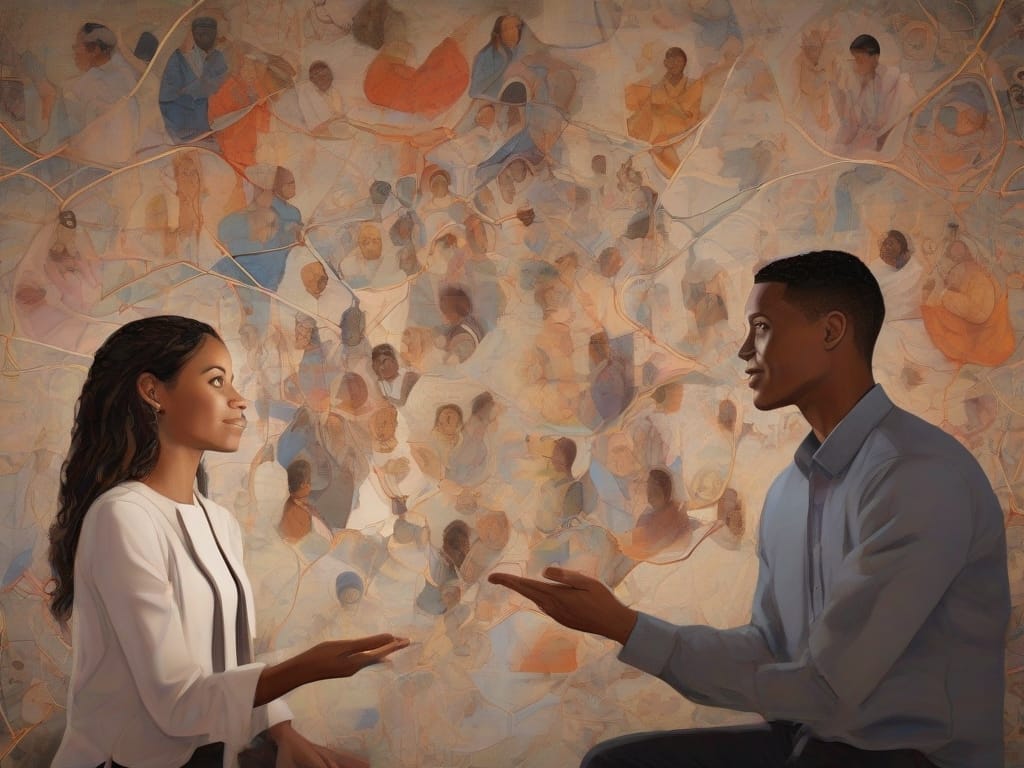Introduction
Have you ever been in a conversation and noticed that the person opposite you copies your gestures? It’s not just a coincidence; it’s the fascinating dance of mirroring behavior. Picture this: you cross your legs, and they do the same. You gesture with your hands, and like a shadow, they follow suit. The question lingering in the air is not merely, “Why does someone mimics your body language?” but rather an exploration into the psychology behind this intricate, often unconscious, phenomenon.
In nonverbal communication, mirroring is important. It happens in nods, facial expressions, and gestures. It’s a silent connection that brings people closer together, without them even realizing it. By understanding mirroring behavior, we can explore the subtle connections between people’s gestures. These connections go beyond words and happen on a subconscious level.
Let’s explore the world of mirroring. Each movement reflects a strong connection. Every cue reveals the unspoken language of human interaction.
Key Takeaways:
Congratulations on navigating the intricate realm of mirroring behavior! As you think about the way we communicate without words, here are the main things to remember.
- Explore the fascinating world of mirror neurons and learn how they copy actions and behaviors.
- Discover the deep effect of mirroring on our psychology, improving social bonds and rapport.
- Discover the silent influence of empathy. People copy others because they want to connect. Empathy is powerful.
- Unravel the emotional and psychological underpinnings that fuel mirroring behavior.
- Discover how mirroring elevates likability and fosters harmonious social interactions.
- Experience heightened empathy and understanding as individuals connect on a deeper level.
- Understand how social situations, cultural differences, and gender affect how people imitate others.
- Understand the difference between mirroring and manipulation. Be aware of crossing that line.
- Develop an eye for the signs that someone is mirroring your body language.
- Learn how mirroring affects different relationships, like work and love, and what that means.
- Improve your self-awareness by learning to understand how others reflect your behavior.
- Use mirroring to build trust and deepen connections.
- Know when and how to address mirroring behavior in various interactions.
- Summarize the important things we learned about mirroring on this journey.
- Embrace and use body language mirroring to strengthen your relationships and interactions.
As you learn from these lessons, use what you’ve discovered to understand gestures in conversations. Use this knowledge to build connections with others. Happy mirroring!

Understanding Mirroring Behavior
A. An explanation of mirroring and its importance in psychology
Mirroring is when you reproduce someone’s body language, gestures, or expressions. It’s like having a non-verbal verbal exchange without replacing an unmarried phrase. Mirroring is more than copying; it’s a dance that connects people and builds bridges.
Mirroring is important in social interaction. It shows the unspoken language that connects us.
B. Explanation of Mirror Neurons and their Role in Mimicking Actions and Behaviors
Enter mirror neurons, the maestros behind the symphony of mirroring. These neural marvels fire both when we perform an action and while we examine someone else doing the same. It’s the brain’s way of saying, “I see you, and I sense you.” By activating at the same time, we can copy others and create stronger bonds with them.
C. How Mirroring Benefits Social Bonding and Rapport-Building
Picture yourself in a set. When you study someone, you notice them copying your moves. That’s the chameleon impact in action, and it’s a powerful device for building rapport. Research shows that mirroring is a manner to reveal a hobby and create a connection.
The Unconscious Nature of Body Language Mirroring
A. Study on Why People Unconsciously Copy Other People
Have you ever noticed how, in social situations, people tend to mimic every difference without uttering a word? It’s no longer an insignificant twist of fate but a subconscious act deeply rooted in our human nature. The need for connection drives us to unconsciously reflect on those around us.
When we use body language, we copy both actions and feelings, creating a silent bond.”
B. The Role of Empathy and the Human Need for Connection
Understanding and sharing someone’s feelings is crucial for mirroring body language. Empathy is key. Our brain connects with others, creating shared emotions that can’t be described with words.
“Mimicking body language is like saying, ‘I feel what you feel.’”
C. Emotional and Psychological Motivations Behind Mirroring Behavior
From job interviews to romantic relationships, the act of mirroring holds significant sway. Studies show that mirroring is an herbal way to hook up with others without figuring out it. It’s now not just copying; it’s a way of announcing, “I’m on the same wavelength as you.”
“The unconscious mimicry of body language is the silent language of human connection.”
How to Recognize If Someone Is Copying Your Nonverbal Cues
So, how can you decipher if someone is mirroring your every move? Look out for those subtle cues:
- Posture Parallels: If the person you’re interacting with mirrors your posture, it’s a strong sign of unconscious mimicry.
- Emulating Gestures: Watch for gestures that echo yours; it’s a subtle manner of announcing, “I resonate with you.”
- Subconscious Synchronization: In group settings, specifically among pals or colleagues, you may locate mirroring happening without conscious attempt.
“Mirror, reflect at the wall, who’s mimicking my gestures despite everything?”

The Benefits of Mirroring
A. Improved Likability and Rapport
Imagine this: You’re having a lively chat and be aware the other person copying your movements without knowing it. That’s now not only a sign of exact vibes; it’s the magic of likability and rapport building in movement. Mirroring creates an unstated bond that makes interactions smoother and more fun.
B. Enhanced Compassion and Perception
When a person mirrors your body language, it’s like they’re entering into your shoes—figuratively and from time to time quite literally. This empathetic mirroring fosters a deeper understanding between individuals. It’s as if the unspoken language of mirroring opens a channel for shared feelings and emotions.
C. Creating a Harmonious Atmosphere
Ever been a part of a set where everybody seems to move in sync, developing an ecosystem of harmony? Mirroring performs an essential position in establishing this collective rhythm. Whether amongst friends, colleagues, or maybe celebrities within the public eye, mirroring contributes to the advent of snug and cohesive surroundings.
D. Table of Mirroring Benefits
| Benefit | Description |
|---|---|
| Enhanced Rapport | Mirroring builds an unspoken bond, creating a sense of similarity and shared understanding between individuals. |
| Improved Communication | By mirroring body language and gestures, communication becomes more fluid, leading to clearer and mutual understanding. |
| Establishing Trust | Mirroring fosters trust as it conveys sincerity and authenticity, making others feel heard and validated. |
| Effective Leadership | Leaders who master mirroring can inspire and influence their teams more effectively, creating a cohesive work environment. |
| Cultural Sensitivity | Mirroring can defuse tense situations by promoting empathy, and helping conflicting parties find common ground. |
| Conflict Resolution | Mirroring can defuse tense situations by promoting empathy and helping conflicting parties find common ground. |
| Negotiation Success | In negotiations, mirroring builds a rapport that can facilitate compromise and lead to mutually beneficial agreements. |
| Enhanced Persuasion | Mirroring enhances persuasive efforts, as people are more likely to be swayed by those who mirror their communication style. |
| Increased Likability | Being mirrored tends to make individuals feel more positively towards the person mirroring them, enhancing likability. |
| Emotional Connection | Mirroring fosters a deep emotional connection, making interactions more meaningful and memorable. |
Situational Factors Influencing Mirroring Behavior
A. The Impact of Social Context on Mirroring
Mirroring is important in various situations, like work and personal relationships. People instinctively copy each other’s body language to connect. Mirroring in professional settings can show agreement and create unity among colleagues. Similarly, in friendships and romantic relationships, it becomes a silent language, speaking volumes about emotional connection.
B. Cultural Differences in Mirroring Behavior
Culture adds another layer to the intricate tapestry of mirroring. In numerous cultures, mirroring may additionally appear otherwise, encouraged by way of societal norms and expectancies. Some cultures see mirroring as respectful, while others locate it intrusive. Understanding these cultural nuances is crucial to decoding the language of mirroring.
C. Gender Differences in Body Language Mirroring Tendencies
Gender dynamics further contribute to the complexity of mirroring behavior. Studies show that men and women may have different ways of imitating someone else’s body language. While some argue that gender plays a minimal role, subtle differences often emerge. Exploring these differences unveils the intricate interplay between biology, socialization, and individual preferences.

Recognizing Mirroring Behavior in Relationships
I. Signs to Look for When Someone is Mirroring Your Body Language
Mirror, mirror on the wall—how do you recognize when someone is trying to mirror it all? The signs are subtle yet significant. Pay close attention when you’re talking to someone, and they seem to mirror your every gesture. It’s more than a coincidence; it’s a strong indication that they’re seeking a connection. Look out for these cues:
- Gaze: If someone copies the way your eyes move or maintains eye contact, it’s a sign of subconscious mirroring.
- Behavior Mimicry: Whether it’s the way you cross your arms or the subtle nod when you speak, mirroring behavior means they’re trying to build a rapport.
- Emulating Expressions: From a smile to a frown, if the person copies the nuances of your facial expressions, it’s a good sign they’re trying to feel more connected.
- Body Language in Groups: In a group setting, observe if someone mirrors your actions, especially in a bid to fit in or gain approval.
II. Understanding the Potential Implications of Mirroring in Various Relationships
Mirror, mirror on relationships—what do these reflections mean? Mirroring is more than just copying. It has different meanings in personal, professional, and romantic relationships.
- Personal Relationships: Mirroring in personal relationships often signifies an attempt to establish closeness. It might be a way of expressing affection and shared experiences.
- Professional Dynamics: In the expert realm, mirroring may be an effective device for building rapport. But be cautious not to overdo it, because too much mirroring can appear faux.
- Romantic Connections: Mirroring in a romantic context can be a way of flirting, signaling a preference to align together with your mind and feelings. But, it’s vital to differentiate real connection from manipulation.
III. The Fine Line Between Mirroring and Manipulation
Mirror, mirror, where does mirroring end, and manipulation begin? While mirroring is generally a positive social cue, there’s a fine line to tread. Here are considerations to keep in mind:
- Intent Matters: Mirroring with the intent to build rapport or express affinity is positive. But if someone uses mirroring to manipulate, it becomes worrisome.
- Authenticity vs. Imitation: Understanding the difference between authentic connection and imitation is crucial. Genuine mirroring enhances relationships, while imitation might lead to misunderstandings.
- Awareness of Boundaries: It’s called mirroring, not mimicry. To have wholesome relationships, it’s vital to admire non-public boundaries and not pass too a ways.
Methods for Handling Mirroring Behavior
A. Developing Self-Awareness: The Internal Mirror
The first step in navigating the mirroring maze is enhancing self-awareness. When you word someone mirroring your moves, pause and reflect. Ask yourself, “Why does this individual experience the want to imitate me?” Recognizing and deciphering mirroring can provide valuable insights into the dynamics at play.
B. Making Use of Mirroring: Brick by Brick Construction of Trust
Mirroring isn’t continually a signal of mimicry; it can be a device for building trust and rapport. When you find yourself in a state of affairs with plenty of mirroring, keep in mind it is a silent invitation to attach. To become closer and strengthen your bond, use this body language with the other person.
C. Addressing Mirroring: When to Break the Dance
Mirroring is powerful, but sometimes we need to address this behavior. If you feel mirroring is more than a friendly dance and could be manipulation or insincerity, speak up. Trust your instincts and have an open conversation about the dynamics at play.
D. Mirror, Mirror Everywhere: From Celebs to Your Inner Circle
Mirroring happens in many different situations, not just specific ones. It is a language that everyone understands. Mirroring is always present, whether with friends, celebrities, or in the corporate world. Nonverbal communication is a silent way to connect and affect how people interact with each other.
E. The Psychology Behind the Mirror: Insights from the Experts
Psychologists weigh in on the significance of mirroring in our daily interactions. It’s more than just imitating; it’s a reflection of the attitude and emotions of another person. Knowing how mirroring works can help you understand others and build genuine relationships.
My Journey into the Mirror of Connection
In my life, mirroring art connected me with others in surprising ways. It played a silent role, like a protagonist in a mosaic. On a cool fall afternoon, I went to a networking event that focused on mirroring.
While talking to people, I noticed how they copied each other’s actions. A fellow attendee mirrored my animated gestures, creating an unspoken symphony of connection. The question, “Why does someone mimic your body language?” lingered in the air, and curiosity led me down a rabbit hole of exploration.
The Tale of a Mirrored Connection
In a cozy coffee shop, I found myself across from an old friend, Sarah. As we talked about life, I noticed something interesting. Every time I drank my coffee, Sarah did too. It wasn’t a conscious effort, but rather the silent agreement of camaraderie.
We studied how people imitate each other and interpret body language that brings us together. We realized mirroring wasn’t copying actions; it showed how connected we were. The unconscious synchronization of our movements mirrored the harmony of our friendship.
While we were talking, we discussed the psychological basis of mirroring. This involves mirror neurons and empathy. I realized the mirroring showed not only actions but also emotions and understanding.
The story didn’t end there. Mirroring is a useful tool in the professional world. It helps build bridges and encourage collaboration during negotiations. Cultural differences and gender dynamics added complexity to the art of mirroring.
On this journey, I learned to mirror others to strengthen relationships and understand them better. I can still hear the coffee shop conversation. It reminds me of the way we all understand each other without words.
Embracing the Reflections
In summary, exploring mirroring was more than understanding. It became a personal journey of connection and self-awareness. In life, the mirror doesn’t show our actions, but the dance of relationships. Mirroring deepens our bonds.
As you explore mirroring behavior, may you discover connections in unexpected places. Look at yourself in the mirror and think about how we communicate without words.

FAQs: Why does someone mimics your body language?
How does mirroring body language play a pivotal role in deciphering flirtatious cues, and what facial expressions must one be attuned to when trying to recognize if people might replicate your gestures throughout a social interaction?
Mirroring a person’s body language plays a pivotal function in deciphering flirtatious cues, as it’s a strong sign of appeal. When trying to understand if people might mirror your gestures during social interaction, pay close attention to facial expressions such as prolonged eye contact, subtle smiles, and open body postures.
These cues often indicate that the person is subconsciously mirroring your movements, a non-verbal way of establishing rapport without uttering a word.
Can you explain how human behavior is connected to the primal instinct of mirroring? Do people copy each other’s body language, like monkeys do, especially when flirting? How do facial expressions contribute to silent communication in this complex dance?
Human behavior is intricately connected to the primal instinct of mirroring, much like how monkeys copy each other’s gestures. When flirting, human beings often unconsciously mirror the person they are attracted to, and this will be located in a collection of buddies or even in a one-on-one interplay.
Facial expressions come into play as silent communicators, with research displaying that the activation of certain mind regions is related to admiration and the mindset of every other man or woman. It’s a subtle dance that often goes unnoticed, but the impact on establishing a connection is undeniable.
Can you explain how copying someone’s body language affects flirting? And how do facial expressions come into play?
Copying another person’s body language significantly affects flirting dynamics. When someone is subconsciously mirroring your mannerisms, it creates a feeling of closeness and connection. However, it’s important no longer to move overboard or make it too overt, as actual mirroring is often a subconscious act.
Facial expressions, especially making eye contact, play a key role in this non-verbal promotion of intimacy. Studies have shown that people are more likely to mirror someone they feel close to, emphasizing the importance of understanding the subtle nuances of mirroring in the complex art of flirting.
Does mirroring mean he likes you?
Mirroring someone’s words or facial expressions might convey a degree of attraction, interest, or connection, which could be interpreted as a sign that he likes you. It represents an attempt to establish a mental and emotional connection with you. However, mirroring alone cannot indicate whether or not he likes you. It’s crucial to take into account additional traits as well, such as his overall mannerisms, body language, the amount of time and focus he devotes to you, and his general treatment of you. You might have a deeper comprehension of his sentiments for you by taking into account mirroring along with all these factors.
Is mirroring considered a form of flattery in relationships?
In partnerships, mirroring may be interpreted as a means of expressing gratitude and respect for the other person. It might be interpreted as flattery when someone adopts a similar communication style or conduct as another person. This mimicry may indicate that the imitator respects the other person’s choices and viewpoints enough to model themselves after them.
Mirroring someone else’s speech or body language, for example, might convey that you appreciate the way they choose to express themselves. This type of subtly mimicking behavior can be seen as nonverbal praise, implying a degree of familiarity and bond between people. Ultimately, mirroring in relationships may indeed be considered a form of flattery, reflecting a sense of admiration and appreciation.
Does a man imitating your choice of words show respect towards you?
It might be interpreted as a sign of respect when a man mimics your word choice. This shows that he respects your ideas and opinions enough to take them into account while crafting his sentences. It implies a degree of respect and adoration for you as a person and shows that someone values your opinions and point of view. He indicates that he values your opinion and thinks it is worthy of attention by incorporating your comments into his communication style. In the end, this conduct may be seen as an indication of respect for your knowledge and perspective.
What does it signify if a man mimics your words when he is around you?
When a man mimics your words or mirrors your choice of words while in your presence, it often signifies his attempt to establish a deeper connection with you. This behavior suggests that he is interested in syncing up with your thoughts and feelings on an intellectual and emotional level, not just on a surface level. By repeating your words or speaking in a similar style, he is conveying a desire to create a sense of camaraderie and understanding with you. Essentially, mimicking your words could be an indication that he is looking to form a more profound and meaningful connection beyond casual conversation.
Does mirroring indicate that a guy is into you or respects you?
Mirroring behavior can suggest that a guy is interested in establishing a deeper connection with you. When a man mirrors your speech patterns and words, it may indicate that he is seeking alignment on an intellectual and emotional level, beyond just physically syncing up. This mirroring could be a way for him to communicate his desire to understand you better and nurture a more meaningful bond. Ultimately, mirroring may be a sign that he loves spending time with you and wants to further your relationship.
What does it signify when a guy copies your word choice?
A person who mimics your word choice may divulge a great deal about his intentions and sentiments towards you. This type of behavior might mean that he values you, wants to know more about you, or is trying to establish a closer relationship with you. You may discover more about a guy’s deepest feelings and ideas if you can figure out why he is mimicking your word choices.
This can help you comprehend his intentions and the dynamics of your connection. Interpreting the meaning behind such mirroring behavior is crucial for a better understanding of the person’s goals since language and communication play major roles in exposing parts of a person’s inner thoughts and feelings.
Is mirroring a way for someone to seek approval?
Someone may utilize mirroring as a means of blending in. To establish a connection and create a sense of relatedness, people sometimes imitate the actions, emotions, or speech patterns of others. Imitating someone else might indicate a desire for acceptance or approval from that individual. People may imitate others in an attempt to win their favor or acceptance by acting similarly to them and establishing a connection.
It’s important to remember, though, that mirroring by itself may not always indicate a conscious effort to win acceptance; it can equally be a subconscious activity motivated by a desire for social peace or to foster a constructive relationship. When analyzing mirroring behavior, one should take additional indicators and the context into account as a potential indicator of seeking approval.
In what ways may mirroring encourage compassion and empathy?
Empathy and understanding can be shown by imitating the behaviors, dispositions, and body language of the other person. Replicating someone involves subtly and nonverbally adopting their behavior. This creates a feeling of rapport and connection because it communicates to the other individual that you understand and empathize with their emotions and studies. Mirroring can assist in establishing acceptance as true and rapport in a verbal exchange using making the opposite person’s sense heard and verified.
It indicates that you’re attuned to their feelings and that you’re engaged and gifted in the interplay. Additionally, mirroring can enhance conversation and foster a deeper feel of know-how between people, as it creates a feel of synchrony and harmony inside the interaction. Overall, mirroring is an effective tool for demonstrating empathy and expertise because it allows you to connect to others on a deeper level and talk your assistance and harmony without words.
Is it a Good Sign if He Mirrors Your Choice of Words?
Indeed, it’s usually a positive indicator when you duplicate someone else’s word choice since it shows that they are paying attention and finding your words interesting. Mirroring implies a subconscious alignment of thinking and communication styles, which can foster a feeling of rapport and connection between two people. It’s a nonverbal indicator that they are focusing on you and maybe even attempting to build a stronger rapport based on empathy or understanding. To effectively determine someone’s interests or intentions, it’s crucial to take into account other contextual elements in addition to mirroring behavior and avoid overanalyzing it alone.
Conclusion
The art of mirroring in human interaction connects people without speaking. Let’s summarize the important things we learn when we look at how people copy each other.
The Dance of Connection:
- Mirroring extends beyond mimicry; it’s a dance of shared emotions and understanding.
- Mirror neurons are important for how we interact with others. They create a special connection between us.
Unconscious Harmony:
- The unconscious nature of mirroring reveals the profound human need for connection.
- Emotional and psychological motivations intertwine, creating a canvas of shared experiences.
Benefits Beyond Words:
- Mirroring enhances likability, fostering rapport in social interactions.
- Increased empathy becomes the silent bridge that spans the gaps between individuals.
Navigating Varied Landscapes:
- Culture, social context, and gender dynamics influence mirroring.
- Recognizing the fine line between genuine mirroring and potential manipulation is crucial.
Strategic Responses:
- Self-awareness is like a guiding light. It helps us navigate the complex dance of mirroring.
- Leveraging mirroring becomes a tool for building trust and deepening connections.
As we try to understand each other, let these insights guide us in building connections. In daily life, you’ll see that actions are more powerful than words, like echoing mirrors.
Your Journey Begins:
Embark on your journey armed with the silent language of mirroring. Pay attention to small details and signals in every interaction to form connections. Mirroring can help in professional, friendship, and romantic situations to create strong bonds.
As you enter the world, holding a mirror, remember that the reflections you create are not just images. They are the brushstrokes that connect people in the masterpiece of life. Happy mirroring!

Sarah Andrews’ work on relationships is informed by a breadth of experience and a strong interest in human nature. Sarah, who holds a Psychology degree and has a good eye for nuances, delves into the complexity of communication and emotion, delivering insightful insights for readers seeking personal growth and emotional pleasure. Sarah hopes that her empathic approach and insightful suggestions will motivate readers to understand themselves and their relationships better.
